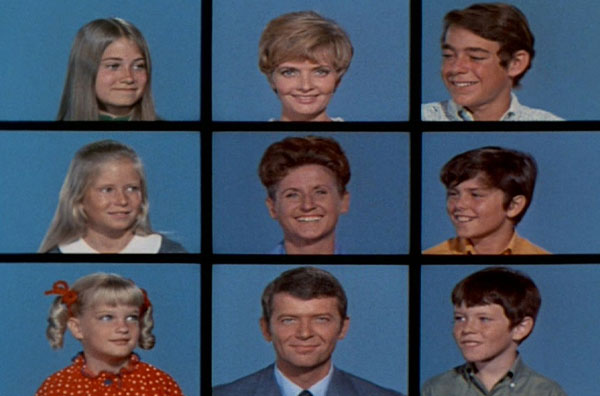40% of all American marriages are a second marriage for one or both spouses. This is according to PEW research published in 2015. That same study found that 22% of children (under the age of 18) live with parents who are either in their second marriage or cohabitating with someone other than the child’s birth parent. It also notes 13% of all adults are step-parents to children under the age of 18. Without proper planning, the distribution of the parental estate could result in children not receiving equal shares.
Take from this what you will, but the fact is, the American family is changing, and has been dramatically since the 1960’s. The most famous of these families in American Pop-Culture, is of course the Brady Bunch. We all know the story — Mike Brady and his three sons lived all alone. Carol Martin was in the same predicament with her three blond daughters; the youngest one had curly hair. One day, Mike met Carol, they fell in love and eventually they got married. Starting in 1969 and running for 117 episodes until 1974, television viewers turned into ABC for 30 minutes each week and were introduced to a new kind of American family which had cat and dog, sister and brother, Mother and Father originally from separate families now all living together under one roof, as one family. While today’s blended families may not be exactly the same, the Brady Bunch showed us the future of many American families.
Per Stirpes
Per Stirpes is a Latin word meaning “By roots” and it is a method of distributing the assets of a deceased person (their estate). The basic idea is as follows: A husband and wife have three children. Over the course of time, the children all get married and have two children each. Later, the wife dies and all of her belongings go to her husband. Then, one of the children of the husband dies. Then, the husband dies. Using per stirpes, his assets are distributed in the following manner:
- The two living children each get 1/3 of the estate.
- The two children of the child who died (the husbands grandchildren) split the remaining 1/3, giving them each 1/6 of the estate.
- The children have stepped into the place of their parent
- They share that persons portion
That is the basic idea and there are several different variations of a per stirpes distribution, such as “per stirpes for those living” and “per stirpes by capita” but how these variations can alter distribution is for a later discussion. One of the most important things to remember regarding per stirpes is that it involves descendants of the deceased, or as we will see, those from whom the deceased descended.
Intestate
When a person dies and they do not have an estate plan in place, that is known as “dying intestate” and then the State determines who gets what. In Illinois, this is done by statute. Each state has their own way of distributing the assets of people who die intestate. Illinois has The Probate Act of 1975, which is part of the Illinois Compiled Statutes (ILCS) and known as 755 ILCS 5.
In order to avoid dying intestate, a person must have at least a will. It does not need to be complicated or fancy, but it needs to be done. And it needs to be done while the grantor, that is the person writing the will who is granting certain people the authority to claim the assets, is still capable of making sound decisions. While some people think of an estate plan as only something rich people do and as being a whole bundle of documents, including a will, a trust, a power of attorney over property, a power of attorney over healthcare, possibly a designation of standby guardianship, etc., the truth is, an estate plan can be very simple and very modest. The more assets a person has, the more complex their life may be, it follows that they may need a more complex estate plan. However, those who have more modest lifestyles can easily get by with a more modest estate plan. Simply stating “all of my belongings to my spouse”* can be an estate plan — in other words, you have created an estate plan by planning, in writing, what will happen to your estate.
(*Simply stating “all of my belonging to my spouse” is NOT legal advice and in my opinion not a good idea, it is used as an illustration in this context about how estate plans can be simple in nature.)
Distribution by the State
In Illinois, the State uses a per stirpes formula for distributing the assets of those who die intestate. 755 ILCS 5/2.1 gives multiple scenarios of how assets shall be distributed.
a) “If there is a surviving spouse and also a descendant of the decedent: 1/2 of the entire estate to the surviving spouse and 1/2 to the decedent’s descendants per stirpes.”
b) “If there is no surviving spouse but a descendant of the decedent: the entire estate to the decedent’s descendants per stirpes.”
c) “If there is a surviving spouse but no descendant of the decedent: the entire estate to the surviving spouse.”
And it continues on and on to cover numerous situations which fall along the line of — if there is no spouse or descendants, then to parents and siblings or descendants of siblings of the decedent. And if none of those, then to grandparents, aunts, uncles, cousins, etc. continually moving in an upward and outward directions of the family tree, until finally, options (g) and (h).
g) “If there is no surviving spouse, descendant, parent, brother, sister, descendant of a brother or sister, grandparent, descendant of a grandparent, great-grandparent or descendant of a great-grandparent of the decedent: the entire estate in equal parts to the nearest kindred of the decedent in equal degree (computing by the rules of the civil law) and without representation.” And if all of that fails,
h) Any real estate goes to the county in which it is located, and the real property belongs to the county in which the person resided before they died.
While the State covers many scenarios regarding distribution, as it has been mentioned before, each scenario revolves around “descendants”. It is either descendants of the deceased, or those from whom the deceased descended.
The Blended Family
While not a majority of families, blended families including children under 18 years old are a strong minority of families. And, according to a 2010 study nearly 1/3 of all marriages formed a stepparent relationship. Not only are 22% of children under 18 years old in some form of step-parent relationship. But blended families are growing in number, in part as Americans live longer and as older people are becoming more accustomed to re-marrying. 42% of adults responded that they are one or more of the following: a stepparent, a step or half sibling, or are a stepchild.
When a parent with children marries (either for the first or subsequent time) they create a blended family. The new parent will either adopt the children or not. If they adopt the children, the children will legally be seen as descendants. If they do not adopt the children, while they may be living as a family and have a daily parent/child relationship, legally, the children are not descendants of the new parent, for inheritance purposes. There are very real and common reasons as to why adoption is not a part of the blended family. If the children have two living parents, and the other birth parent is not willing to give up their parental rights, the new parent cannot adopt the children. Adoption is expensive, and it is possible that the new parent does not want to (or cannot) undergo the expense. If the children are adults, most don’t even consider adoption. If you do not adopt the children, under the laws of per stirpes, they are not descendants and they are not included as parties when dividing up your estate. It is settled law that descendants take from only one family line (mother and father).
If Mike and Carol Brady adopted each other’s children when they got married and then after 117 episodes of their television show, packed up the station wagon and moved the family from their Southern California home to Illinois and then Mike died intestate, by Illinois law Carol would receive 1/2 of Mike’s estate, and the children would each get 1/12 of the estate (1/6 of the remaining 1/2). Then, when Carol died, the children would each receive 1/6 of her estate (or 1/12 of the total estate). In the end, each child ends up with an equal 1/6 of the total estate.
The result is an equal distribution of the estate.
In the same situation, if Carol dies first and dies intestate, Mike gets 1/2 of Carol’s estate and the children would each get 1/12 of the estate (1/6 of the remaining 1/2). Then when Mike died intestate, each boy would get 1/3 of the estate and the girls would get nothing. Each girl sill ends up with 1/12 of the estate while each boy still got 1/4 of the total estate.
The result is an unequal distribution of the estate.
If both ex-spouses were still alive and prevented both Mike and Carol from adopting any of the other’s children, then if Mike died first and died intestate, Carol would get 1/2 of the estate and Greg, Peter, and Bobby would each get 1/6. The girls would get nothing. Then, when Carol died and died intestate, the Marcia, Jan, and Cindy would each get 1/3 of her estate. The boys would get nothing. In the end each child ends up with an equal 1/6 of the total estate.
The result is an equal distribution of the estate.
It is common in blended families that the spouses bring their own assets into the relationship, rarely are each spouse’s assets an even 50 – 50 split of the entire estate. To illustrate how this can affect asset distribution, consider the following: If the children are not adopted, and if Mike holds 100% of the assets in the family and if Carol dies first and dies intestate, Mike takes 1/2 the girls each take 1/6 and the boys take nothing. Seeing as how Carol has nothing to divide, nobody get anything. Then, when Mike dies, and dies intestate, the boys each get 1/3 of the estate and the girls get nothing. In the end the boys each get 1/3 of the estate and the girls got nothing.
The result is an unequal distribution of the estate.
For the final example, let’s say that none of the children were adopted by Mike or Carol. Shortly after the family trip to Hawaii, Marcia, Jan, and Cindy all die surrounded by mysterious circumstances. Years later, Mike dies intestate leaving Carol and the Boys. Carol will take 1/2 of Mike’s estate and the boys will each get their 1/6 share. Years later yet, when Carol dies and dies intestate, having no spouse and no descendants, her estate will pass to her parents (if they are alive) or her siblings (if they are alive) or to her nieces and nephews. It is very likely, depending on Carol’s age, her entire estate will end up going to Cousin Oliver. So Greg, Peter, and Bobby each get 1/6 and Cousin Oliver gets 1/2.
The result is an unequal distribution of the estate.
There are a numerous scenarios where the family estate is not shared equally among all children depending on: If the children are adopted or not, which spouse owns how much of the estate, and which spouse dies first. This can often result in unequal distributions of an estate, and it doesn’t matter if the family has been together for many, many years and if the parents see the children as their children and the children see the parents as their parents. Without planning, children can be inadvertently left out.
One way to ensure equity in estate distribution in a blended family is by utilizing an estate plan. Estate plans allow you to leave your money, home, furniture, etc. to whomever you want in whatever way you want. You can name each person “Greg, Marcia, Bobby, Jan, Peter, and Cindy” to whom you choose to leave your estate, and how they should divide it “to divide evenly”. An estate plan is often cheaper, more effective, and more reliable than fighting it out in probate court.





